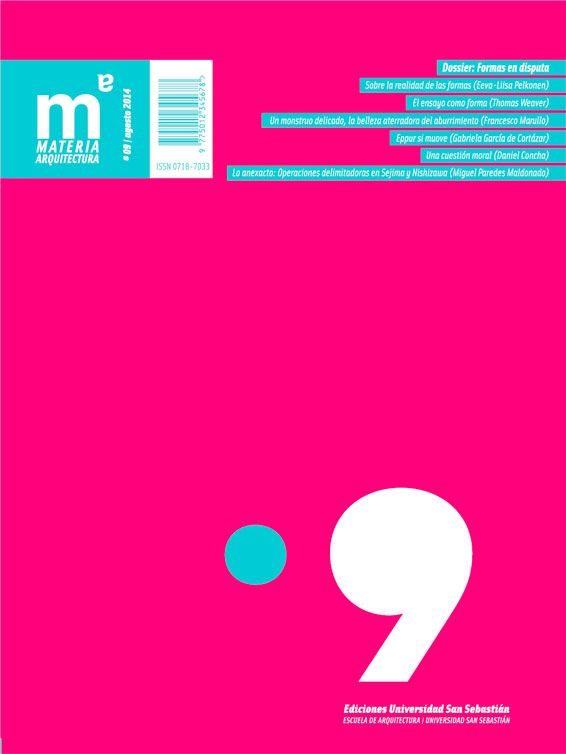A Delicate Monster. Three passages on the terrifying beauty of boredom
Barra lateral del artículo
Palabras clave:
Contenido principal del artículo
Resumen
Centuries of literature depicted boredom as the hidden malaise of modernity: a disease of the soul which progressively separated
man from his natural endowments, weakening his capacity of self-reflection into indifference.
Yet, paradoxically it is boredom one of the distinctive traits of the post-Fordist economy: that condition of unresolved longing, when
the soul is suspended within an uncertain presentness and life is experienced “as such”, open to unforeseen possibilities. If in the
past labor activities were functionally limited within spatial rigid enclosures, on the contrary contemporary modes of production tend
to flaunt the intrinsic indeterminacy and genericness of the human potential providing empty stages for life to be simply performed.
In this sense, boredom could be considered the index of human indeterminacy, the place where life is contemplated in its pure
freedom: that formless state of hesitation necessary for either realizing or not its embedded potential. When any distinction between
labor and life dissolved into action, form can no longer be considered as a steady object, but rather as a process of differentiation
through which life becomes itself, stemming out of a context as the conscious expression of an inner drive, a “form-of-life”.
Detalles del artículo
Materia Arquitectura proporciona acceso inmediato y gratuito a todos los contenidos de esta edición electrónica, publicada simultáneamente con la edición impresa. Materia Arquitectura no cobra honorarios a los autores por ningún concepto.
Todos los contenidos de esta edición electrónica se distribuyen bajo licencia Creative Commons de “Atribución-Copartirigual 4.0 Internacional” (CC-BY-SA).
La licencia Creative Commons permite el acceso libre e inmediato al contenido y permite que cualquier usuario lea, descargue, copie, distribuya, imprima, busque o genere enlaces a los textos completos de los artículos, permitiendo también que estos puedan ser rastreados para indexarlos, pasarlos como datos a software o usarlos para cualquier otro propósito legal. Asimismo, la licencia otorga derechos de uso a quienes a su vez utilicen una licencia abierta (Creative Commons o equivalente).
Los derechos de los textos y las imágenes publicadas pertenecen a sus autores, quienes otorgan a Materia Arquitectura la licencia para su uso. La gestión de los permisos y la autorización de publicación de las imágenes (o de cualquier material) que contenga derechos de autor y sus consecuentes derechos de reproducción en esta publicación es de exclusiva responsabilidad de los autores de los artículos.
Toda vez que mencionen su origen, los autores son libres de distribuir sus artículos por otros medios. Cualquier reproducción total o parcial del material deberá citar su procedencia.
Descargas
Citas
AGAMBEN, G. (2004). The Open. Man and Animal (K. Attel, Trad.). Stanford: Stanford University Press.
BATAILLE, G. (1985). Formless. En G. Bataille, Visions of Excess. Selected Writings, 1927-1939. (A. Stoekl, Trad. y Ed., pág. 31) Mineápolis: University of Minnesota Press.
BURKE, E. (1958). A Philosophical Enquiry into the Origin of Our Ideas of the Sublime and Beautiful. Londres: Routledge (1a. ed., 1757).
KANT, I. (1961). Observations on the Feeling of the Beautiful and Sublime (John T. Goldthwaite, Trad.) University of California Press (1a ed., 1764).
KRACAUER, S. (1995). The Hotel Lobby. En S. Krakauer, The Mass Ornament. Weimar Essays (T. Y. Levin, Trad. y Ed., págs. 173-185) Cambridge, Mass.: Harvard University Press.
LYOTARD, J. F. (1994). Lessons on the Analytic of the Sublime. (Elizabeth Rottenberg, Trad.) Stanford: Stanford University Press.
SIMONDON, G. (2006). Individuazione Psichica e Collettiva (Muriel Combes, Introdución; Paolo Virno, Trad. y Ed.). Roma: Derive e Approdi (1a ed., 1989).
VIRNO, P. (1994). Mondanità. L'idea di 'mondo' tra esperienza sensibile e sfera pubblica. Roma: Manifestolibri.
WORRINGER, W. (1997). Abstraction and Empathy. A Contribution to the Psychology of Style (M. Bullock, Trad.) Chicago: Ivan R. Dee. (1a ed. 1908).
Artículos más leídos del mismo autor/a
- Francesco Marullo, Un monstruo delicado, tres pasajes sobre la belleza aterradora del aburrimiento , Materia Arquitectura: Núm. 09 (2014): Materia Arquitectura 09 (Agosto/August 2014)
